Batuan Temple in Bali
Batuan Temple is one of the most popular and beautiful village temple which is part of three major temples in a village that is called Tri Kahyangan, and designed with Balinese architecture with split gates, stone guardians, thatched shrines, and detailed carvings.
The Batuan Temple, referred to locally as Pura Puseh Batuan is a focal landmark in the namesake village of Batuan, well-known for its traditional Balinese arts and paintings. one of three village temples dedicated to the gods of the Hindu trinity
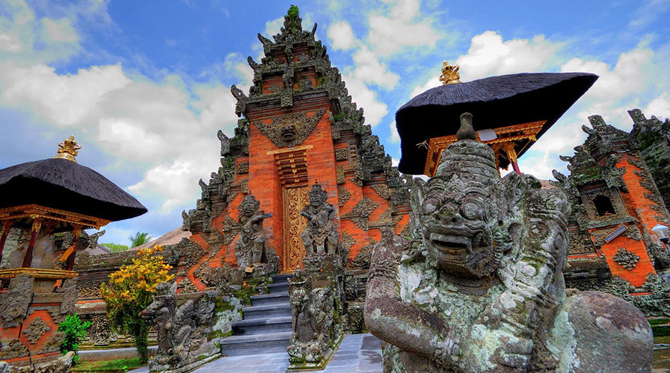
As a classic example of a Balinese village temple trio that’s well located between south Bali and Ubud, Batuan Temple is a popular stop on Bali cultural and temple tours.
The temple features a grand complex of shrines laid out within its 0.65Ha complex. Well preserved sandstone bas motifs and well-preserved traditional Balinese temple architecture are its main draws.
As usual temple in Bali, Batuan Temple is also featured by the three areas includes Nista Mandala (outside area) Madya Mandala (Middle area) and Utama Mandala (Main temple area).
The entry gate to the temple appears as a split gate as if it was formed once as one gate that was split into two parts. This gate leads into a courtyard which has a garden and a galaxy of statues fixed at various locations.
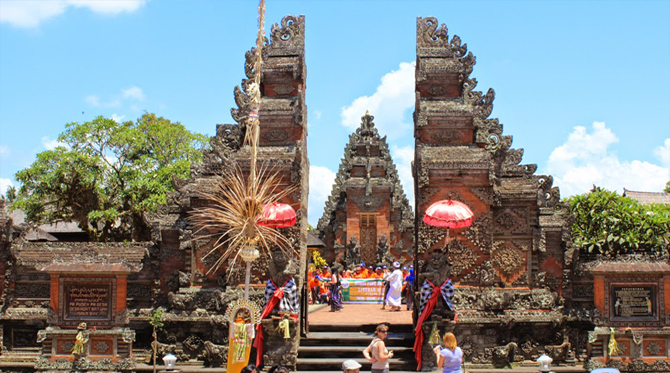
From the courtyard, there is another gateway spanned by an intricately carved arch with bass relief on the inset and intertwined with vines and a closed door. The entry to the sanctum is again through two gates.
The sanctum is where the gods are enthroned during festival time through a special invitation to “come down into this world.” The gods invited during the festivals are venerated with deep devotion and offerings.
We are going dig deep to inform you everything you need to know before you visit Batuan Temple, but feel free to jump to any section that interests you:
- Batuan Temple History
- Batuan Temple Address & Map Location
- How to get to Batuan Temple
- Batuan Temple Entrance Fee
- Batuan Temple Opening Hours
- Batuan Temple Dress Code
- What to Expect at Batuan Temple
- Batuan Village
- Batuan Painting
- Batuan House
Batuan Temple History
Batuan Temple is mentioned in historical records as far back as 1000 years. The Hindu and Indian influence in the region in the village is evident from the carvings and temples.
Batuan Temple was founded in 944 isaka (1020 AD). Which is part of the ‘Tri Kahyangan’ or ‘Tri Murti’ concept taught by Mpu Kuturan to the Balinese Hindu community in the 10th century.
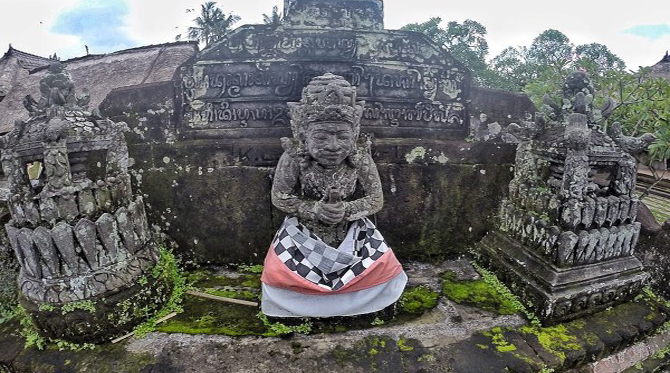
This incorporates a Desa or Village Temple as a place to worship God Brahma (the Creator), a Puseh Temple to worship God Vishnu (the Preserver), and a Dalem Temple to worship Lord Shiva (the Destroyer).
The name “Batuan” or “Baturan” mentioned here prompts villagers to joke about being “tough as stone” or “eating rocks” — as batu means “stone” in Balinese.
But it likely refers to an ancient megalithic tradition in which standing stones served as meeting places and ceremonial sites for the worship of ancestral spirits.
However Batuan became a center from which Buddhist priests and brahmans spread to the main court centers of south Bali, the village has an unusual preponderance of brahmans.
Batuan Temple Address & Map Location
Batuan Temple located at Jalan Raya Batuan, Batuan village, Sukawati, Gianyar regency, Bali, Indonesia.
Approximately 7 miles (10 kilometers) from Ubud, or 15.5 miles (25 kilometers) from Seminyak, and within 55 minutes drive away from Denpasar Ngurah Rai International Airport via Jl. By Pass Ngurah Rai.
How to Get to Batuan Temple
To get to Batuan Temple or Pura Puseh Batuan has strategic location which is easily accessible from any area of Bali, and can be reached by bemo minibus from Batubulan, or renting a scoter and car with driver.
As we mentioned earlier, Batuan Temple is located in the middle of Batuan Village beside the main road from Denpasar to Ubud. And the site features a grand complex of shrines laid out within its 0.65Ha complex.
If you coming from Nusa Dua area just take the way to Bali Mandara Toll Road. Then follow Jl. Nusa Dua – Bandara Ngurah Rai – Benoa Toll Road/Mandara Toll Road and Jl. By Pass Ngurah Rai to Jl. Raya Batubulan and Jl. Celuk Sukawati/Jl. Raya Celuk to Jl. Raya Batuan in Batuan.
Within 1 hour drive by car or scooter from Seminyak or 24km away, and 40 minutes from Sanur, but will be depending of the road traific.
However if you coming from Ubud it only takes 22 minutes drive by car or scoter within 9,8-kilometer away.
Batuan Temple Entrance Fee
There is no entrance fee required when you visit Batuan Temple, however local people expect any tourist visiting this temple can donate the amount of money to support the maintenance of the temple.
There is provided a simple donation box. Every donation you give should be based on a sense of sincerity, where the Balinese know it was called “Medana punia”.
And please be respectful at all times. Wear a sarong while visiting this temple complex, and make sure bare knees and shoulders are not visible.
Batuan Temple Opening Hours
Batuan Temple is oper for visitor daily from 09.00 AM to 06.00 PM, however for worship purpose it is open for 24 hours daily.
Best is to witness them during temple anniversaries. Such events occur twice a Gregorian year, since dates are based on a local 210-day calendar.
Ceremonies and temples are an integral part of the local Balinese culture and as an outsider, provide a fascinating insight into the local way of life.
The most popular festival that is observed in Batuan and other places in Bali is the Galungan (meaning "When the Dharma is winning), which is a national festival that occurs over a cycle of every 210 days.
It is the religious belief that Gods descend to the earth on this day. During this festival a long bamboo pole called locally as penjor is made to decorate the entrance to the family compound.
The festival is observed starting with the day of arrival of gods and ends on the 10th day known as Kuningan. During this festival, dancing, music and elaborate decorations and food offerings are a common feature.
Batuan Temple Dress Code
Temples are an integral part of the local Balinese culture and as an outsider, provide a fascinating insight into the local way of life.
However, visitors should keep in mind that temples are holy places of worship and as such, respect should be shown at all times. That goes especially for how to dress appropriately so as not to cause offense.
As you visit of any temples in Bali, both men and women should wear a sarong, scarf or sash tied around the waist.
Sarong and sash is provided in Batuan Temple, and you can use that for free, as long as you visit the temple.
Oher conduct tips to follow are:
- Don’t take photos directly in front of worshippers.
- Don’t Step Over or Tread on Offerings - Small offerings called canang sari are often left on the ground. Palm leaves are woven into a small box and flower petals herbs, money, snacks are inside. These offerings are to appease the spirits. Be careful where you’re walking.
- Don't enter a temple if bleeding - Menstruating women and women who have given birth in the last 6 weeks may not enter temples. Likewise, if you have an open wound or injury you should not enter a temple.
- Respect the local culture - Don't forget that you are in a holy place of worship. Use your common sense and act appropriately. The Balinese welcome visitors of all religions and are happy to share their traditions and customs, so treat their temples as you would your own.
- As long as you remember that the temple you are in is a space of reverence to the Balinese people, and treat it as such, your temple visit is sure to bring you the happiness and enlightenment you seek.
What to Expect at Batuan Temple
Batuan Temple or Pura Puseh Batuan designed with full Balinese ornaments and for the roof, it is made from the fiber of chromatic black palm tree.
The temple also has a parking area facilities, there is a place that is used as a meeting hall to practice any kind of Balinese dances as Gambuh dance Pendet dance, and this place is called Wantilan a standing ancient building.
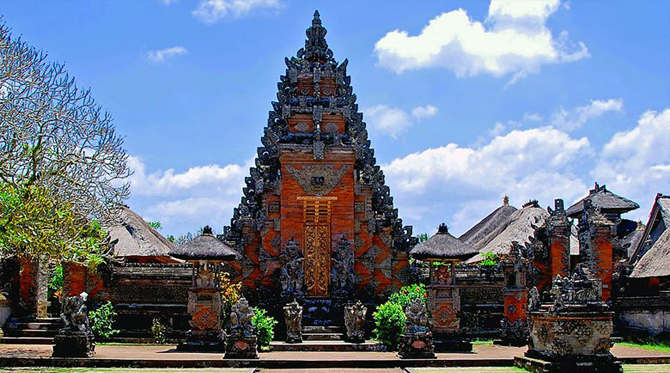
Before entering the temple, locals at Wantilan will lend you a traditional Balinese costume “kamben”. Remember it is a must to wear to show respect and honor. It’s all free and won’t be charged for entrance.
But locals expect donations in their donation box but in any amount of money just for the maintenance of the temple. “Medana punia” is what Balinese call to the sincerity of every donation that you give.
In the central courtyard of the temple there is a long building called Bale Agung and Bale Kulkul (mad gong by wood or bamboo).
In this courtyard there is also the entrance of the High Gate of Bali called Kori Agung, which is flanked by many statues of giant sculpture guards.
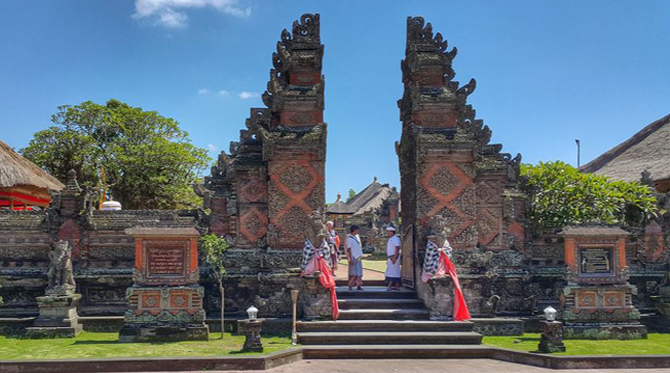
Kori Agung's function is the doorway where the entrance and entry of the gods is represented by a small statue called Pratima.
Next to Kori Agung are two small doors as a place to exit and enter people into the main courtyard of the temple.
Next, in the main courtyard of the temple there are about three stories of Meru and Bale Pengiyasan as a symbol of Besakih temple, there is also a building called Padmasana as a place of worship to Sang Hyang Widhi, the only Balinese Hindu god.
The Batuan Temple or Pura Puseh Batuan not only exudes high spiritual vibrations, but also represents historical value. You can see into it there are many amazing ancient relics from prehistoric times.
How is the influence of Hindu culture in Bali made of natural stone in this temple into a place of worship, both for their ancestors and worship the Hindu gods.
You will be amazed to find some ancient and unique statues there. Based on a number of statues found in this Pura Puseh, can be grouped into several types.
They are Dwarapala Statue, Statue of Embodiment, Animal Statue, Status of Holding Chickens, Phallus, Demons (Time), and many more.
Batuan Village
Batuan village is located in central Bali about 10 kilometres (6.2 mi) south of Ubud and about 15 kilometres (9.3 mi) northeast of Denpasar contiguous to northern Sukhawathi village, another well-known art center.
The land in this part of Bali is very flat. The area covered by the town excluding agricultural lands is 6 square kilometres (2.3 sq mi). The town is bounded by streams flowing through chasms or gorges, which provide water supply to the town.
Apart from the streams that flow through the town, there are also irrigation canals sourced from upstream dams which provide irrigation facilities to large tract of paddy fields that surround the village, which was the back bone of the sustenance economy in the past; economy is now largely dependent on tourist influx and the town is now part of “World Economy.”
By 1995, the village had paved roads. The town has a number of temples hidden in the labyrinth lanes and by lanes of the town but two temples are prominent on the main road.
In addition, there are now concrete paved performance pavilions in the town with high roofs where dance performances are held by many dance groups, which have got established now to cater to the tourism in the town; one such pavilion is in front of the Pura Desa Batuan or Batuan Temple.
Batuan Painting
Batuan village is noted for its artwork and style of painting which originated in the village in the 1930s and has since emerged into a major Balinese artistic style, known as a Batuan painting.
It is a major painting center and contains a number of art galleries and cooperative art societies which have played a key role in promoting the art of Batuan.
Balinese art forms are primarily classified under three major categories of which Batuan Style (distinct from the Ubud Style) which originated in Batuan is one style which has absorbed the traditional art form to the present dynamic art styles;.
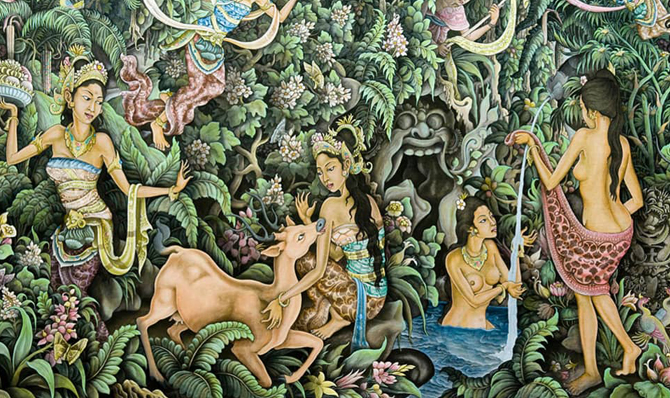
The other two Bali art styles are the Ubud style of Ubed and the Sanur style which have been further supplemented by a "Young Artists" style of 1960s of Penestanan (the artists village) origin influenced by the Dutch artists.
In the Batuan style of painting, the emphasis is adoption of sombre colour, generally in black and white with preponderance of mystic Balinese religious ethos related to sorcery and witchcraft.
They are also famous for the miniature painting with great attention paid to detailing. The artists have an eye for detail as they paint with great patience. Vegetation is drawn in a stylised format, but each leaf is painted and shaded.
The patterns, even in batik sarongs, have the minor figures drawn very carefully. Even the open space is filled with pulsating marks.
Scenes emerge from the canvas and retreat into the vegetation such as a dog fight, a love affair, a group of gamblers, all shown in a corner of the canvas.
Batuan village gave its name to a style of painting which evolved in the 1930s after a group of local villagers, Ida Bagus Made Togog and Ida Bagus Made Wija began experimenting with ink-washed paintings on black backgrounds.
These are popular to this day. The black and white background was said to evoke the supernatural. Artists in Batuan later changed to gouache and acrylics.
In the early years of the Batuan genre art, Batuan artists explored subjects that concerned themselves rather than creating tourist art.
While anthropologists Margaret Mead and Gregory Bateson had a special relationship with Batuan artists, they avoided influencing them and were careful in what Western pictures they were to show to the Batuans.
Batuan artists depicted only a traditional world in their pictures, avoiding objects such as automobiles, until at least the late 1980s.
Anthropologists also interpret that the paintings made by artists of Batuan are visual texts which represent the “Balinese Character”.
Another notable feature is, unlike the Ubud style, the Batuan style also imbued daily life scenes in its depictions, deviating from the traditional. The depiction is of factual scenes but camouflaged in the form of masks.
The colours used by the famous artists of Batuan were more bold than those used in Ubud paintings, with green and maroon being the dominant shades used for depicting human beings. Daily life with a complex variety of activities is depicted in great details.
However, the painting canvases still adopted the three space formula with the bottom part devoted to daily human activities, with ritual activities in the middle section and with the upper section devoted to the realms of gods.
The Batuan painters belonging to the Pita Maha Painters group also created aesthetically elegant paintings combining Buddhist mythology with vivacious and inventive Wayan-style images.
These paintings have also been described as “naïve style works –almost caricatures that depict daily life with humour.” The village is now dominated by galleries of various artists.
Batuan House
Batuan is also famous for its traditional houses with very charming concept of house building consisted on several building with different purpose of activities.
For the most part, Balinese mansions equipped with large mansions include Bale Daja (northern buildings) is a children's room or used as a place of offering.
Bale Dangin or Bale Gede (east-located buildings) used to make offerings, Bale Delod (south set building) will be the kitchen.
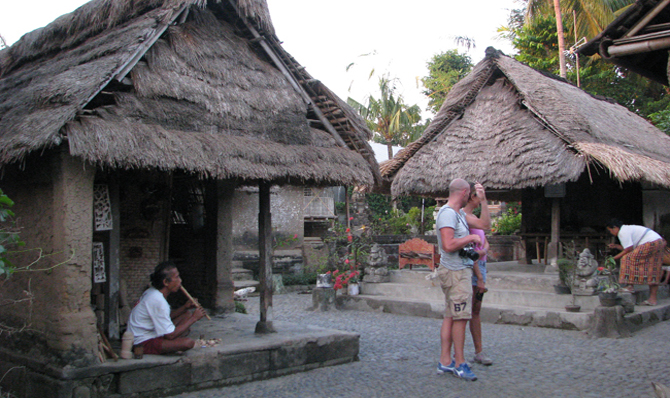
Bale Dauh (western building) is usually used for parents' rooms, and in the northeast in the home area, which is called the family temple, and they make offerings daily.
Traditional Balinese house is a perfect design that takes the concept of Balinese life involved in their daily social life. It can be seen from the design of each building that suits each other.
Each building is equipped with a terrace or balcony for a place to rest. All buildings designed based on Balinese architecture with Asta Kosala - Kosali (fang sui) concept include building measurements taken from homeowner size.
So every family home will have different house measurements ranging from doors, windows, beds to buildings.

Co-Founder of Bali Cheapest Tours
We’re all about cheap holidays and low-cost deals. We've got plenty to satisfy your travel bug on our wide selection of Bali Tour Packages featuring Bali's best places.
Which crafted to match any travel style, travel period, touring needs and budget for a journey that’s perfect for you.
